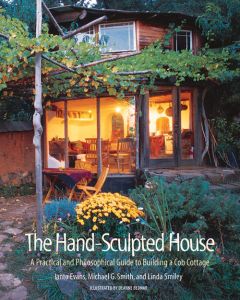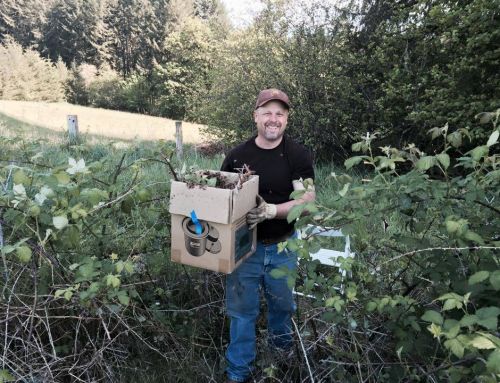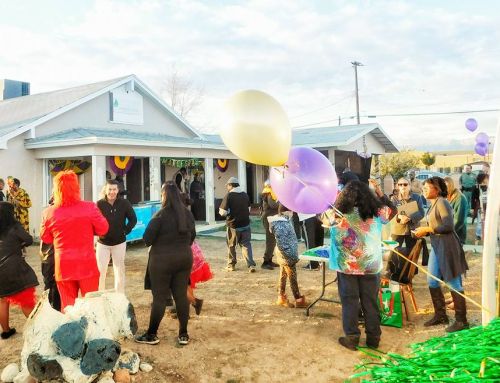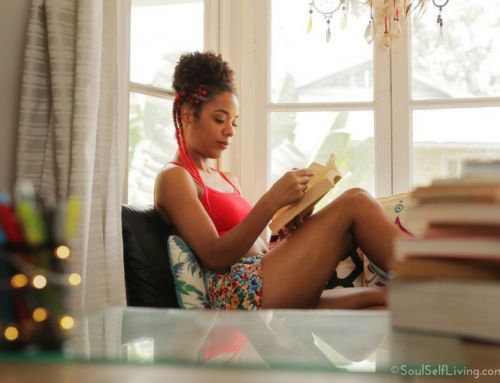
The original home office of the Cob Cottage Company, on the cover of The Hand Sculpted House.
“Oh my God! Oh Wow! This is amazing! Is it OK to come in?” The tiny woman standing outside my door was trembling with excitement and grinning from ear to ear. A few steps behind her, her tall and husky husband stood stoically, his arms folded across his chest. He looked at me with a mixture of skepticism and boredom. This visit was clearly her idea.
It was the 1st Friday of the month, and as manager of the Cob Cottage Company, this was the day I gave tours of the home office to people interested in experiencing a cob house, first-hand. I’d met all types of people during these tours, finely dressed professionals in high-heels, rough-handed contractors in work boots, eager students, hopeful homesteaders, idealists, and skeptics.
The two-storey cottage had been sculpted by the owners, by hand, out of cob: a mixture of sand, clay and straw. There were no square corners in this building. The thick walls, coated with a smooth yet undulating earthen plaster, curved around to create a snug and cozy home that felt as if it were embracing you. Along the wall of the sitting area, a cob bench, heated from within by a rocket stove, was the perfect place to lay down for a warm nap, quietly read a book, or sit with friends and chat.
I welcomed the couple inside, handed them each a cup of tea, and invited them to sit. The woman took her husband’s free hand and eagerly led him to the cushioned bench.
They leaned back against the curved earthen wall’s embrace. What happened next had occurred so many times before that I could predict it with a stop-watch.
Within about two minutes, they were both crying tears of relief as I watched long-held stress leave their bodies.
“When I was a little girl, this is what I imagined a house was supposed to feel like,” she whispered. “I had forgotten. I didn’t think it was even possible to make a house like this nowadays. I feel like I’m in a fairy tale but this is real!”
“Wow”, he said, “I didn’t expect this. I can’t explain it, but I’m really comfortable here. I feel like I’m home; really home. I guess our ancestors lived like this for centuries, right? Maybe my body somehow remembers that this is what a house is supposed to feel like.”
They left feeling more connected with each other, and inspired and excited to see how they could build a home like this for themselves.
I saw them again, a few months later, at one of the company’s hands-on cob construction workshops, where they learned the skills they needed to fulfill their dream.
One of the best things about cob building is how democratic it is. Anyone can make cob and build with it. I have mixed cob, barefoot on a tarp, with singing and dancing children, teenagers, adults, and men and women in their eighties. The non-toxic materials come right from the earth so it’s safe on the body. Professional builders are often surprised to find that there are no dumpsters on a cob building site. There’s no waste going to landfills.
The oldest continually inhabited building in North America, Taos Pueblo, which has been lived in for 1000 years, is made of cob and adobe. From Britain to Yemen, currently occupied cob buildings date back to the 1500’s. These buildings last. And, if they outlive their usefulness, you can remove the roof and allow the elements in. The building will simply return to the earth. This is living in balance with nature.
You can learn more about Natural Building here.
And, make sure and watch the excellent video below.
How about you? Are you interested in natural building? Do you live in a natural home? Leave a comment below!
Rich Blessings, Jack (and Stacey)
Next Steps: If you would like personalized, specific support for your health, take a look at the Channeled Vibrational Healing Intensive and take us up on a spiritual coaching session to get started.




Leave A Comment